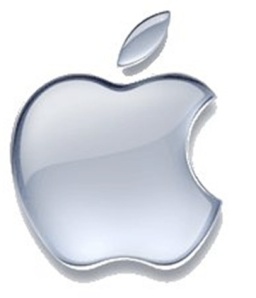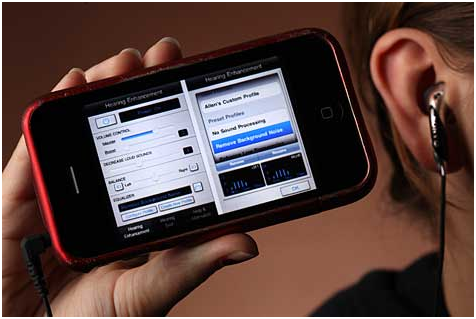Smartphones and Hearing Aids Slowly Merging
Right now, at least 91% of all people on planet earth have a mobile phone. Even more shocking, half of the human population owns a smartphone. These numbers indicate something far greater than mere, well, numbers. Essentially, smartphones are becoming a widespread phenomenon and will begin to individually adapt to everyone’s personal lifestyle, no matter what that may be. Mobile phones are not a new invention, they’ve been around for quite some time and in this day and age, it seems a large majority of smartphone users are permanently attached to theirs. As a result, companies are looking to expand their products and make them fit consumers so specifically, that they’ll never be able to go back. All implementations are a little bit different from each other, but what they all share in common is that they were specifically tailor for a certain target audience. Take for example this phone case that lights up to allow the perfect selfie to be taken, or on the other end of things, consider that most smartphones are being integrated with hearing aids!
It seems to be a niche market, that’s for sure. But it’s one that is revolutionizing the lives of millions and making the hearing loss discussion one that is far more common, as it should be. There are apps that have been created for the smartphone in order to give a hearing test at the convenience of the user. Not to mention, it allows them to be able to put themselves in the shoes of others who are hard of hearing and experience how they hear. Even more so, hearing aid models are being entirely integrated with smartphones in order to be controlled entirely via phone.
As the trickle down effect runs it course, mobile devices will continue to evolve to reach all kinds of individuals, as it has already proven to do so. For example, there are already a number of applications on the app store that are available for those who are experiencing hearing loss and more are sure to follow suit. The most notable app for smartphones, however, is one that translates sound from people and converts it to a text form, allowing hard of hearing users to seamlessly communicate.
The growth and relevance of smartphones show absolutely no sign whatsoever of slowing down and it appears that children are even joining the craze at a younger and younger age! But what this means is that there will be more specialized markets in order to cater to those who have different needs. More importantly, the integration of smartphones and hearing aids is proving to help remove a great deal of hearing aid stigma. By joining forces with one of the most prevalent devices of our time, hearing aid stigma could soon be a thing of the past and allow for more people to speak freely and seek the help they need.
Read Full Post | Make a Comment ( None so far )New Hearing Aids that are Compatible with Apple Products
(CNN) — People wait in long lines and even camp out to get their hands on new Apple devices as soon as they’re available. But they drag their feet, sometimes for years, when it comes to purchasing another piece of technology that could greatly improve their lives: hearing aids.
Hearing-aid manufacturers and audiologists hope a new collaboration between them and Apple will help.
Danish hearing-aid company GN ReSound last week announced a new hearing aid that’s compatible with the iPhone, iPad and iPod Touch. Called LiNX, the device syncs wirelessly with the newest Apple mobile devices and takes advantage of iOS 7’s new accessibility options for the hearing-impaired.
At its most basic level, the LiNX acts like a hybrid of hearing aids and stereo Bluetooth headphones. Phone calls, FaceTime chats, music, movies, turn-by-turn navigation or other audio can be streamed directly to a small earpiece. When they’re not pulling in audio from a smartphone or tablet, the hearing aids work like normal, picking up in-person conversations and surrounding sounds.
Read more about LiNX here.
Read Full Post | Make a Comment ( None so far )A Really Smart Solution to the Hearing Aid: The Soundhawk
Traditional hearing aids, the ones that cost $2,000 and up, are designed to amplify sound. They contain little microphones, most of which, today, are inserted in the ear canal. They amplify the sounds around you, be they spoken words, music, a crowd of people, or an airplane flying overhead. A hearing aid amplifies them all without distinction as to what might be important to you. So, if I am talking to you on a busy city street, both my voice and the sound beyond my voice will be louder, and if you have the typical age-related presbycusis, you won’t understand me much better than if you weren’t wearing an aid at all.
But the Soundhawk operates differently. You can tell it what you want to hear and it will amplify those sounds in particular. That makes it smart… aside from the fact that you send it instructions from your smart phone. And style-wise, the Soundhawk is understated, even cool, and that makes it perfect for us boomers who wouldn’t want anyone to think we needed a hearing aid!
Seriously, though, the Soundhawk does represent an advancement in the hearing aid world, especially for those of us with mild to moderate hearing losses, most of it caused by our youthful enthusiasm for rock music. By focusing on amplification of only one source – indoors, outdoors, restaurant, or driving – you can listen (aka: pay attention to) the sounds you want to hear and minimize sounds you don’t want to hear.
If you want to hear what your dining companion is saying in a crowded restaurant (yes!), your Soundhawk will amplify his voice and minimize the crowd noise. If you want to be able to hear the street sounds around you while you walk to work, you can listen to those, or you can listen to the TV or an outdoor concert and minimize the sound of the people talking around you. This ability is aided not only by the ‘Scoop’ earpiece and the smart phone app (iPhone or Android) settings, but by an additional microphone that you can place near the source of the sound you are choosing.
Read more about Soundhawk here.
Read Full Post | Make a Comment ( None so far )Next BIG Thing: Apple & Hearing Aids
People wait in long lines and even camp out to get their hands on new Apple devices as soon as they’re available. But they drag their feet, sometimes for years, when it comes to purchasing another piece of technology that could greatly improve their lives: hearing aids.
Hearing-aid manufacturers and audiologists hope a new collaboration between them and Apple will help.
Danish hearing-aid company GN ReSound last week announced a new hearing aid that’s compatible with the iPhone, iPad and iPod Touch. Called LiNX, the device syncs wirelessly with the newest Apple mobile devices and takes advantage of iOS 7’s new accessibility options for the hearing-impaired.
At its most basic level, the LiNX acts like a hybrid of hearing aids and stereo Bluetooth headphones. Phone calls, FaceTime chats, music, movies, turn-by-turn navigation or other audio can be streamed directly to a small earpiece. When they’re not pulling in audio from a smartphone or tablet, the hearing aids work like normal, picking up in-person conversations and surrounding sounds.
Apple worked closely with ReSound on the hearing aid and assisted them in publicizing its launch. And this being Apple, there are plenty of bells and whistles packed into the device.
To read more, click here.
Apple Wins Hearing, Hearing Loss Continues
Over the past few years, a court decision and its subsequent appeals have made many Americans pay more attention to hearing loss than ever before. That case is Birdsong et al. v. Apple Inc. In this case, Joseph Birdsong and Bruce Waggoner (the plaintiffs) claimed that the design of Apple’s iPod earbuds, as well as the power of the iPod’s audio itself could prove extremely dangerous to one’s hearing, and that Apple could be held responsible for hearing loss, and that the Apple should release financial compensation (to the two plaintiffs), research on hearing damage in iPod users, overall improved safety of the iPod, and redesigned headphones.
In the latest appeal ruling (Argued and Submitted October 8, 2009; Filed December 30, 2009), the court stated that Apple is not responsible for hearing loss, and in the words of the judge’s opinion: “The plaintiffs do not allege the iPods failed to do anything they were designed to do nor do they allege that they, or any others, have suffered or are substantially certain to suffer inevitable hearing loss or other injury from iPod use.” and later continues “At most, the plaintiffs plead a potential risk of hearing loss not to themselves, but to other unidentified iPod users.”
Even with the win in the original case (in 2006), Apple released a new update to its iPod software in 2006 that allowed users to cap the decibel range of the device, redesigned the iPod’s headphones, and released guidelines to give iPod users a better idea of the short and long-term ramifications of loud music exposure. In Europe, Apple was even required to cap the volume levels of all iPods sold within the EU. Even still, many continue to blast their iPods at full strength, especially younger users who do not truly understand the long-term ramifications of improperly using such a device.
The professionals at Miami’s New Generation Hearing Centers recommend that you always listen to your personal music device (such as an iPod) at a safe volume level, and also recommend that you use noise-reducing headphones for your personal listening pleasure, especially if you tend to listen to music in noisy environments (so that you do not feel the need to turn the volume all the way up past “safe” levels). Also, do not be afraid to have your hearing checked regularly; even if you are experiencing extreme hearing hearing damage or loss, hearing professionals such as New Generation’s Dr. Joseph K. Duran can give you the hearing help to help you live a normal life again.

Apple won an appeal in a case and was once again held not responsible for hearing loss caused by iPods.
